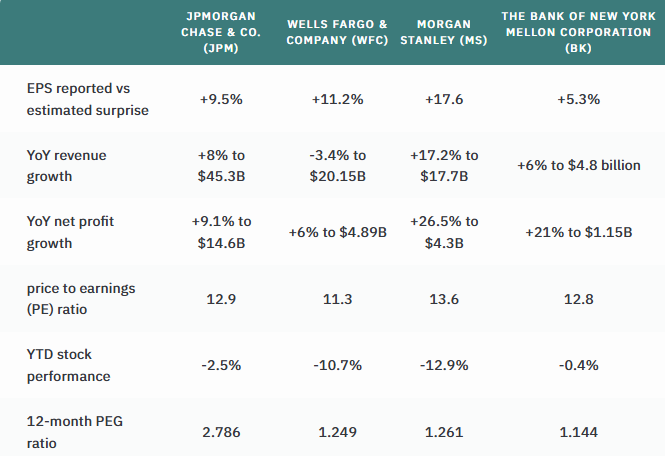The walkback of global reciprocal tariffs introduced a temporary relief in the markets, having brought back the S&P 500 (SPX) index to early April level. It is now uncertain if President Trump’s “Liberation Day”, as a way to restore the US manufacturing base, will materialize as intended.
In the meantime, the US economy continues to be highly financialized, as evidenced by latest banking earnings for Q1 2025. All four big banks, JPMorgan Chase (NYSE:JPM), Wells Fargo & Company (NYSE:WFC), Morgan Stanley (NYSE:MS) and Bank of New York Mellon (NYSE:BK), exceeded their earnings per share (EPS) estimates.
But which banks represent the strongest exposure at current stock price points?
Banking Earnings Roundup
Listed on the New York Stock Exchange (NYSE), only BK shares are up year-to-date. Likewise, over a one-year period, BK stock is the most performant at 40% shareholder return while WFC is the least performant at 10% gains in the same period. JPM and MS are equalized at 28% and 25% one-year returns respectively.
Q1 2025 earnings showed Morgan Stanley (MS) as the clear winner in terms of EPS surprise, revenue and net profits, which mirrors its highest PE ratio. MS shareholders are now paying the most for each dollar of anticipated earnings at 13.6 P/E, although not by much compared to peers.

Representing long-term growth consensus by dividing P/E with expected earnings growth rate, JPM has the highest PEG ratio while other banks are equalized. This makes sense as JPMorgan Chase is the largest bank in the US, benefiting from the network effect.
JPMorgan was also one of the banks that suffered muted market turmoil effects at -2.5% YTD stock performance. In this light, BNY Mellon provides investors with the most balanced exposure ratio for risk-averse investors.
Which Bank Has the Highest Stock Buyback?
Of the four banks, Wells Fargo (WFC) was the only one with negative year-over-year revenue growth, having reported $20.15 billion revenue vs expected $20.75 billion. Income from net interest via loans was the main culprit for this drop, having fallen by 6% YoY to $11.5 billion.
To keep WFC stock steady in Q1, the bank executed a $3.5 billion stock repurchase program, returning back 44.5 million shares. For comparison, JPMorgan Chase, which has a 3x larger market cap than Wells Fargo, purchased $7.1 billion worth of its own shares in the same period.
Morgan Stanley’s stock buyback program remains the same as last year’s quarter, at $1 billion. Relative to their respective market caps, here is how all the four banks’ stock repurchase programs line up as a percentage in Q1 2025. We can then compare it again with their YTD stock performance.

The fact that Wells Fargo used the most capital relative to its market cap for stock buyback is not that surprising. After all, the bank regularly receives poor customer service reviews, which also reflected poorly on its net interest income this quarter.
In terms of dividend yields on top of stock returns, the four banks are nearly equalized: WFC (2.56%), JPM (2.37%), BK (2.42%), and slightly higher MS (3.42%).
The Bottom Line
What Lockheed Martin (NYSE:LMT) is to the Pentagon, JPMorgan is to the Federal Reserve. Or even better, what Microsoft (NASDAQ:MSFT) is to the Big Tech, JPMorgan is to the Big Bank.
And just like Big Tech, the largest ones thrive on acquisition for future growth. JPMorgan is the most active in this area, having bought the collapsed First Republic Bank (OTC:FRCB) in early 2023, while also increasing stakes in Cleareye.ai and C6 Bank in Brazil.
On top of 500 more planned branches in the US, the largest American bank is also expanding its reach into the EU with its digital bank Chase, which is expected to ramp up in late 2025 and during 2026. Given that JPMorgan is de facto a commercial extension of the Federal Reserve, to which Europe’s ECB relies upon, it is likely that JPMorgan’s standing will accrue much greater customer volume than neobanks like Revolut.
Combining JPMorgan’s digital innovation with physical reach, and its systemic status pillar, investors should view JPM stock as part fortress and part disruptor. For risk-averse investors, this is the best place to be.
***
Neither the author, Tim Fries, nor this website, The Tokenist, provide financial advice. Please consult our website policy prior to making financial decisions.
This article was originally published on The Tokenist. Check out The Tokenist’s free newsletter, Five Minute Finance, for weekly analysis of the biggest trends in finance and technology.
